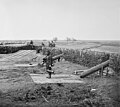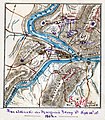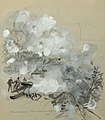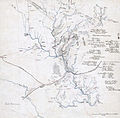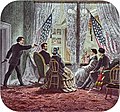 |
 |
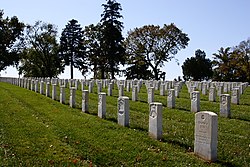
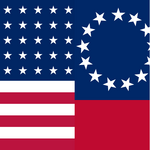
The American Civil War (1861–1865) was a sectional rebellion against the United States of America by the Confederate States, formed of eleven southern states' governments which moved to secede from the Union after the 1860 election of Abraham Lincoln as President of the United States. The Union's victory was eventually achieved by leveraging advantages in population, manufacturing and logistics and through a strategic naval blockade denying the Confederacy access to the world's markets.
In many ways, the conflict's central issues – the enslavement of African Americans, the role of constitutional federal government, and the rights of states – are still not completely resolved. Not surprisingly, the Confederate army's surrender at Appomattox on April 9,1865 did little to change many Americans' attitudes toward the potential powers of central government. The passage of the Thirteenth, Fourteenth and Fifteenth amendments to the Constitution in the years immediately following the war did not change the racial prejudice prevalent among Americans of the day; and the process of Reconstruction did not heal the deeply personal wounds inflicted by four brutal years of war and more than 970,000 casualties – 3 percent of the population, including approximately 560,000 deaths. As a result, controversies affected by the war's unresolved social, political, economic and racial tensions continue to shape contemporary American thought. The causes of the war, the reasons for the outcome, and even the name of the war itself are subjects of much discussion even today. (Full article)
The 91st Pennsylvania Volunteer Infantry was a Union infantry regiment which fought in multiple key engagements of the American Civil War, including the Battle of Fredericksburg, Battle of Chancellorsville and Battle of Gettysburg. It was established through the combined efforts of Edgar M. Gregory, who had received approval from the U.S. War Department to begin recruiting soldiers for an entirely new regiment during the fall of 1861, and Edward E. Wallace, who had initiated his own recruitment efforts that October. Their recruits were volunteers, the majority of whom initially enlisted for three-year terms of service from their hometown of Philadelphia; they were divided into 10 lettered companies upon muster in during early December 1861: A, B, C, D, E, F, G, H, I, and K. (In later years, as the war dragged on and the need for reinforcements arose, additional men were drafted from communities across the state.)
The men who enrolled with the 91st Pennsylvania wore modified Zouave uniforms (dark blue Zouave-style jacket and vest with yellow trim, sky blue sash, sky blue pantaloons, and red fez with blue tassel). The regiment's leaders were presented with the unit's First State Color on December 6, a flag which had been manufactured by Horstmann Brothers and Company. (Full article...)

During the American Civil War, most of what is now the U.S. state of Oklahoma was designated as the Indian Territory. It served as an unorganized region that had been set aside specifically for Native American tribes and was occupied mostly by tribes which had been removed from their ancestral lands in the Southeastern United States following the Indian Removal Act of 1830. As part of the Trans-Mississippi Theater, the Indian Territory was the scene of numerous skirmishes and seven officially recognized battles involving both Native American units allied with the Confederate States of America and Native Americans loyal to the United States government, as well as other Union and Confederate troops.
Most tribal leaders in Indian Territory aligned with the Confederacy. A total of at least 7,860 Native Americans from the Indian Territory participated in the Confederate Army, as both officers and enlisted men; most came from the Five Civilized Tribes: the Cherokee, Chickasaw, Choctaw, Creek, and Seminole nations. The Union organized several regiments of the Indian Home Guard to serve in the Indian Territory and occasionally in adjacent areas of Kansas, Missouri, and Arkansas. (Full article...)
Jefferson F. Davis (June 3, 1808 – December 6, 1889) was an American politician who served as the first and only president of the Confederate States from 1861 to 1865. He represented Mississippi in the United States Senate and the House of Representatives as a member of the Democratic Party before the American Civil War. He was the United States Secretary of War from 1853 to 1857.
Davis, the youngest of ten children, was born in Fairview, Kentucky, but spent most of his childhood in Wilkinson County, Mississippi. His eldest brother Joseph Emory Davis secured the younger Davis's appointment to the United States Military Academy. Upon graduating, he served six years as a lieutenant in the United States Army. After leaving the army in 1835, Davis married Sarah Knox Taylor, daughter of general and future President Zachary Taylor. Sarah died from malaria three months after the wedding. Davis became a cotton planter, building Brierfield Plantation in Mississippi on his brother Joseph's land and eventually owning as many as 113 slaves. (Full article...)
- ... that singer Frank Croxton performed a duet with his father for the unveiling of a monument to a Confederate States Army general?
- ... that after the Little Rock campaign, Union forces held three-quarters of Arkansas?
- ... that Romeo and Juliet both served in the Union Navy?
- ... that The Land We Love, a little magazine that merged into Southern Magazine, printed American Civil War recollections, poetry, agricultural material, and many works by female authors?
- ... that Byron Root Pierce was Michigan's last living Civil War general?
- ... that Chinese-born Joseph Pierce enlisted as a Union Army soldier, fought at the Battle of Gettysburg during the American Civil War, and was made a corporal?
- Attention needed
- ...to referencing and citation • ...to coverage and accuracy • ...to structure • ...to grammar • ...to supporting materials
- Popular pages
- Full list
- Cleanup needed
- The West Tennessee Raids
- Requested articles
- James Ashby (soldier) • Bluffton expedition • Benjamin D. Fearing • Charles A. Hickman • Richard Henry Jackson • James B. Speers • Charles S. Steedman • Battle of Barton's Station • Lawrence P. Graham • Thomas John Lucas • Daniel Henry Rucker • James Hughes Stokes • Frederick S. Sturmbaugh • Davis Tillson • Action at Nineveh (currently a redirect) • International response to the American Civil War • Spain and the American Civil War • Savannah Campaign Confederate order of battle • Native Americans in the American Civil War (currently disambiguation after deletion) • 1st Battalion, Mississippi Mounted Rifles (Union) • Battle of Lafayette • Requested American Civil War Medal of Honor recipients
- Expansion needed
- Battle of Boonsborough • Battle of Guard Hill • Battle of Rice's Station • Battle of Simmon's Bluff • Battle of Summit Point • Charleston Arsenal • Edenton Bell Battery • First Battle of Dalton • Blackshear Prison • Edwin Forbes • Hiram B. Granbury • Henry Thomas Harrison • Louis Hébert (colonel) • Benjamin G. Humphreys • Maynard Carbine • Hezekiah G. Spruill • Smith carbine • Edward C. Walthall • Confederate States Secretary of the Navy • Confederate States Secretary of the Treasury • David Henry Williams • Battle of Rome Cross Roads • Delaware in the American Civil War • Ironclad Board • United States Military Railroad • Kansas in the American Civil War • Rufus Daggett • Ebenezer Magoffin • Confederate Quartermaster-General's Department • First Corps, Army of Northern Virginia • Francis Laurens Vinton • Henry Maury • Smith's Expedition to Tupelo • Other American Civil War battle stubs • Other American Civil War stubs
- Images needed
- Battle of Lone Jack • Preston Pond, Jr. • Melancthon Smith
- Merging needed
- 1st Regiment New York Mounted Rifles and 7th Regiment New York Volunteer Cavalry
- Citations needed
- 1st Alabama Cavalry Regiment (Union) • 4th Maine Battery • 33rd Ohio Infantry • 110th New York Volunteer Infantry • Battle of Hatcher's Run • Camp Dennison • Confederate colonies • CSS Resolute • Dakota War of 1862 • Florida in the American Civil War • Ethan A. Hitchcock (general) • Fort Harker (Alabama) • Gettysburg (1993 film) • Iowa in the American Civil War • Second Battle of Fort Sumter • Samuel Benton
- Translation needed
- Add an article here!
The following Wikimedia Foundation sister projects provide more on this subject:
-
Commons
Free media repository -
Wikibooks
Free textbooks and manuals -
Wikidata
Free knowledge base -
Wikinews
Free-content news -
Wikiquote
Collection of quotations -
Wikisource
Free-content library -
Wikiversity
Free learning tools -
Wikivoyage
Free travel guide -
Wiktionary
Dictionary and thesaurus
- Shortcuts to this page: Portal:ACW • P:ACW





